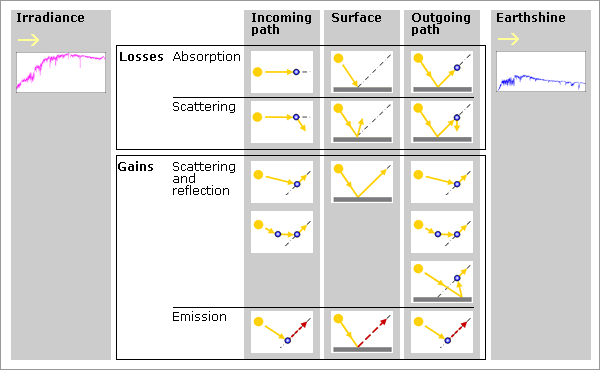The earthshine spectrum as measured by a satellite-borne spectrometer is the result of the imprinting of the already complex solar spectrum with additional features that are the result of interactions in the atmosphere during the incoming or outgoing paths of the radiation, or at the surface of the Earth. During the passage of sunlight through the atmosphere and its interaction with the surface of the Earth a large number of interactions such as scattering on molecules and aerosols can take place that lead to both gains and losses in the intensity of the radiation. These effects can mask or distort the effects we wish to measure, which is the characteristic absorption of light by the respective species. These interactions consist of:
- losses from the absorption of radiation and the scattering or reflection of radiation out of the line of sight;
- gains from the scattering or reflection of radiation into the line of sight;
- gains from thermal emission (although these are negligible in the UV/vis/NIR spectral range except under certain conditions).
The following diagram summarizes these individual interactions.

Fig 3.2.1.1: Interactions of photons in the atmosphere
[Hint: Roll the cursor over the individual elements of the image to see an
explanatory text.]
Image: AT2-ELS
Any permutation of these individual processes can occur, such as scattering, then reflection and then another scattering into the line of sight.
For the purpose of measuring the concentration of a particular species in the atmosphere, the only process that is of interest is the absorption of radiation by molecules of that species. Only the absorption of radiation can give the signature of the absorber that allows us to detect its presence and measure its concentration.
Extracting the spectral absorption information for a particular species from the earthshine spectrum consists principally of removing all the other phenomena that are irrelevant for our task. In order to do this we need to perform the following operations:
- Normalize the earthshine spectrum against the solar spectrum. This process neutralizes the complex spectral features of the solar spectrum that are present in the earthshine spectrum. Normalisation also neutralizes all those instrumental effects that are multiplicative such as wavelength dependent throughput.
-
Compensate for the effects of losses and gains from molecular (Rayleigh)
scattering, aerosol (Mie) scattering, Raman scattering and reflections and
absorptions by clouds and at the Earth's surface.
The procedure that is used to do this is known as Differential Optical Absorption Spectroscopy, or DOAS.